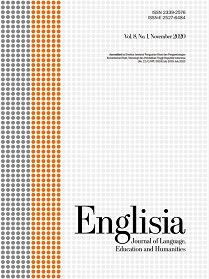Critical thinking skills toward YouTube resources in students' argumentative texts
DOI:
https://doi.org/10.22373/ej.v8i1.6622Keywords:
Argumentative Essay, Critical Thinking, YouTubeAbstract
This study explored critical thinking skills toward YouTube resources in students' argumentative texts. The study was conducted at two non-English majors of the universities in the Indonesian context. The data were in the argumentative forms that were constructed by selected students. This study used a content analysis approach that was involved in coding and categorizing to analyze the data. After the data were analyzed, the findings showed that the patterns of critical thinking elements of the student's argumentative texts were varied, and the integration of technology resources was able to foster critical thinking skills. However, it is based upon the quality of the technology itself and the instruction in the classroom. Thus, technology implementation, YouTube resources should be found on the quality of the resources and teaching in the school.
Downloads
References
Afshar, H. S., Movassagh, H., & Arbabi, H. R. (2017). The interrelationship among critical thinking, writing an argumentative essay in an L2 and their sub skills. The Language Learning Journal, 45(4), 419-433.
Andrews, R. (2007). Argumentation, critical thinking and the postgraduate dissertation. Educational Review, 59(1), 1–18.
Bazalgette, C., & Buckingham, D. (2012). Literacy, media and multimodality: A critical response. Oxford, UK: Blackwell Publishing.
Creswell, J. C. (2012). Education research, planning, conducting and evaluating quantitative and qualitative research (4th ed.). Boston, MA: Pearson.
Facione, P. A. (1998). Critical thinking: A statement of expert consensus for purposes of educational assessment and instruction. Available as ERIC Doc. No.: ED 315 423.
Forster, D. (1997). Stand by me revisited: Group presentations through character studies. ELERI Journal, 5, 4-l2.
Fu, Q., Lin, C., Hwang, G., & Zhang, L. (2019). Impacts of a mind mapping-based contextual gaming approach on EFL students’ writing performance, learning perceptions and generative uses in an English course. Computers & Education, 137, 59–77.
Hidayah, R., Salimi, M., & Susiani, T. S. (2018). Critical thinking skill: Konsep dan indikator penilaian. Jurnal Taman Cendekia, 1 (2), 127-133.
Holsti, O. R. (1969). Content analysis for the social sciences and humanities. Boston, MA: Addison-Wesley.
Holzer, S. M. (1994). From constructivism to active learning, The Innovator, Spring (2). Retrieved from: http://www.succeed.ufl.edu/innovators/innovator_2/innovator002.html.
Huang, S.. (2017). Critical multimodal literacy with moving-image texts. English Teaching: Practice & Critique, 16(2),194-206.
Jiang, L. (2018). Digital multimodal composing and investment change in learners' writing in English as a foreign language. Journal of Second Language Writing, 40, 60–72.
Joiner, R., & Jones, S. (2003). The effects of communication medium on argumentation and the development of critical thinking. International Journal of Educational Research, 39(8), 861–871.
Kadayifci, H., Atasoy, B., & Akkus, H. (2012). The correlation between the flaws students define in an argument and their creative and critical thinking abilities. Procedia - Social and Behavioral Sciences, 47, 802–806. DOI: 10.1016/j.sbspro.2012.06.738
Karakoc, M. (2016). The significance of critical thinking ability in terms of education. International Journal of Humanities and Social Science, 6(7), 81-84.
Karn, R. (1995). Advanced EFL concepts: Teaching double entendre and euphemism through film. ELERI Journal, 3, 51-66.
Liao, F., & Hanauer, D. I. (2016). ESL students’ perceptions of creative and academic writing. In scientific approaches to literature in learning environments. Amsterdam, Netherlands: John Benjamins Publishing Company.
Liu, F., & Stapleton, P. (2018). Connecting writing assessment with critical thinking: An exploratory study of alternative rhetorical functions and objects of inquiry in writing prompts. Assessing Writing, 38, 10–20.
Liu, J. (2018). Cultivation of critical thinking abilities in English writing teaching. Theory and Practice in Language Studies, 8(8), 982-987.
Marzano, R.J., & Kendall, J. S. (2007). The new taxonomy of educational objectives. Thousand Oaks, CA: Corwin Press.
Matsuta, K. (1998). Applications for using authentic materials in the second language classroom. ELERI Journal, 6, 41-44.
McKinley, J. (2013). Displaying critical thinking in EFL academic writing: A discussion of Japanese to English contrastive rhetoric. RELC Journal. 44(2), 195-208.
Passero, T. (1996). Melting down stereotypes using the film: Torch song trilogy. ELERI Journal, 4, 153-159.
Ranalli, J.,, Feng, H., & Chukharev-Hudilainen, E. (2018). Exploring the potential of process-tracing technologies to support assessment for learning of L2 writing. Assessing Writing, 36, 77-89.
Sharadgah, T. A. A. (2014). Developing critical thinking skills through writing in an internet-based environment. International Journal of Humanities and Social Science, 4(1), 169-178.
Stempleski, S. (1995). Teaching communication skills with authentic video. In S. Stempleski & P. Arcario (Eds.), Video in second language teaching: using, selecting and producing video for the classroom (pp. 7-24). Alexandria, VA: TESOL, Inc.
Stupple, E., Maratos, F., Elander, J., & Hunt, T.E. (2016). Development of Critical Thinking Toolkit (CriTT): A measure of student attitudes and beliefs about critical thinking. Thinking Skills and Creativity, 23, 91-100.
Suyono, S. M., Roekhan, & Harsiati, T.(2019). Critical thinking patterns of first-year students in argumentative essay. Journal for the Education of Gifted Young, 7(3), 683-697.
Tai, H., Lin, W. C., & Yang, S. C. (2015). Exploring the effects of peer review and teachers' corrective feedback on EFL students' online writing performance. Journal of Educational and Computing Research, 53(2), 284-309.
Downloads
Additional Files
Published
Issue
Section
License
Proposed Policy for Journals That Offer Open Access
Authors who publish with Englisia journal agree to the following terms:
- Authors retain copyright and grant the journal right of first publication with the work simultaneously licensed under a Creative Commons Attribution License that allows others to share the work with an acknowledgement of the work's authorship and initial publication in this journal.
- Authors are able to enter into separate, additional contractual arrangements for the non-exclusive distribution of the journal's published version of the work (e.g., post it to an institutional repository or publish it in a book), with an acknowledgement of its initial publication in this journal.
- Authors are permitted and encouraged to post their work online (e.g., in institutional repositories or on their website) prior to and during the submission process, as it can lead to productive exchanges, as well as earlier and greater citation of published work (See The Effect of Open Access).









